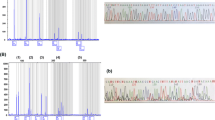Abstract
Postmortem animal interference may be confused at first sight with injuries of vital origin, thus arousing suspicion of external violence preceding death. A reliable classification of the origin of such doubtful injuries is of crucial importance, a fact that is especially true for the investigation of suspected homicide and/or mammade body mutilation after death. In forensic pathology, the identification of injuries as caused by animals postmortem and the classification of a particular species as responsible for a specific injury pattern under question is usually done by forensic pathologists with vast practical experience and special knowledge of the appearance and morphology of tooth marks of carnivores and rodents, respectively. However, a molecular biological investigation of such wounds could provide genetic evidence that an injury pattern present on a corpse was truly caused postmortem by animal interference and thus support the pathologist's expertise. For this purpose, we developed a panel of small species-specific short-tandem repeat systems (<150 bp) for animals typically involved in postmortem scavenging of human remains, such as dogs and cats as well as wild-living rodents (mice and rats) having possible access to death scenes inside apartments or buildings. A specific and sensitive cross-species multiplex polymerase chain reaction was then established including the species-specific animal markers, thus enabling the genetic identification of wounds caused postmortem by different animals on human remains.
Similar content being viewed by others
References
Komar D, Beattie O. Postmortem insect activity may mimic perimortem sexual assault clothing patterns. J Forensic Sci 1998;43:792–796.
Zehner R, Amendt J, Krettek R. STR typing of human DNA from fly larvae fed on decomposing bodies. J Forensic Sci 2004; 49:337–340.
Menotti-Raymond MA, O'Brien SJ. Evolutionary conservation of ten microsatellite loci in four species of Felidae. J Hered 1995;86:319–322.
Padar Z, Egyed B, Kontadakis K, et al. Canine STR analyses in forensic practice. Observation of a possible mutation in a dog hair. Int J Legal Med 2002;116:286–288.
Pfeiffer I, Völkel I, Täubert H, Brenig B. Forensic DNA-typing of dog hair: DNA-extraction and PCR amplification. Forensic Sci Int 2004;141:149–151.
Haglund WD. Contribution of rodents to postmortem artifacts of bone and soft tissue. J Forensic Sci 1992;37: 1459–1465.
Tsokos M, Matschke J, Gehl A, Koops E, Püschel K. Skin and soft tissue artifacts due to postmortem damage caused by rodents. Forensic Sci Int 1999;104:47–57.
Asamura H, Takayanagi K, Ota M, Kobayashi K, Fukushima H. Unusual characteristic patterns of postmortem injuries. J Forensic Sci 2004;49:592–594.
Byard RW. Autopsy problems associated with postmortem ant activity. Forensic Sci Med Pathol 2005;1:37–40.
Tsokos M, Schulz F. Indoor postmortem animal interference by carnivores and rodents: report of two cases and review of the literature. Int J Legal Med 1999;112:115–119.
Ropohl D, Scheithauer R, Pollak S. Postmortem injuries inflicted by domestic golden hamster: morphological aspects and evidence by DNA typing. Forensic Sci Int 1995;72:81–90.
Pötsch-Schneider L, Endris R. Postmortale Hundebißspuren und Leichenfraß. Kriminalistik 1984;38:351–353.
Patel F. Artefact in forensic medicine: postmortem rodent activity. J Forensic Sci 1994;39:257–260.
Rossi ML, Shahrom AW, Chapman RC, Vanezis P. Postmortem injuries by indoor pets. Am J Forensic Med Pathol 1994;15:105–109.
Rothschild MA, Schneider V. On the temporal onset of postmortem animal scavenging. “Motivation” of the animal. Forensic Sci Int 1997;89:57–64.
Mätzler A. Von Hunden getötet und angefressen. Kriminalistik 1977;37:634–636.
Clark MA, Sandusky GE, Hawley DA, Pless JE, Fardal PM, Tate LR. Fatal and near-Fatal Animal Bite Injuries. J Forensic Sci 1991;36:1256–1261.
Lauridson JR, Meyers L. Evaluation of fatal dog bites: the view of the medical examiner and animal behaviorist. J Forensic Sci 1993;38:726–731.
Tsokos M, Schulz F, Püschel K. Unusual injury pattern in a case of postmortem animal depredation by a domestic German shepherd. Am J Forensic Med Pathol 1999;20:247–250.
Bellis C, Ashton KJ, Freney L, Blair B, Griffiths LR. A molecular genetic approach for forensic animal species identification. Forensic Sci Int 2003;134:99–108.
Wetton JH, Higgs JE, Spriggs AC, Roney CA, Tsang CSF, Foster AP. Mitochondrial profiling of dog hairs. Forensic Sci Int 2003;133:235–241.
Schneider PM, Seo Y, Rittner C. Forensic mtDNA hair analysis excludes a dog from having caused a traffic accident. Int J Legal Med 1999;112:315, 316.
Author information
Authors and Affiliations
Corresponding author
Additional information
This study was presented at the Sixth International Symposium in Advanced Legal Medicine (ISLAM), Hamburg, Germany, September 2006.
Rights and permissions
About this article
Cite this article
Schulz, I., Schneider, P.M., Olek, K. et al. Examination of postmortem animal interference to human remains using cross-species multiplex PCR. Forens Sci Med Pathol 2, 95–101 (2006). https://doi.org/10.1385/FSMP:2:2:95
Accepted:
Issue Date:
DOI: https://doi.org/10.1385/FSMP:2:2:95




